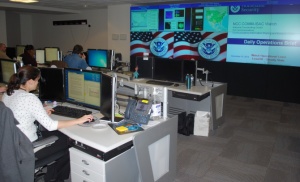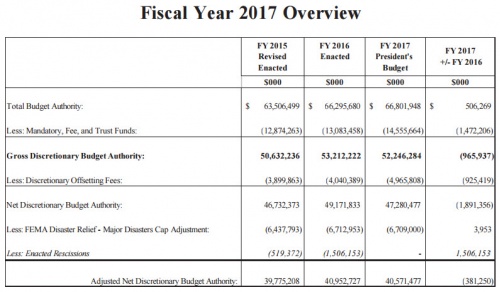Difference between revisions of "Situational Awareness"
(→Responsibilities) |
|||
| Line 53: | Line 53: | ||
NPPD’s programs and activities ensure the timely sharing of information, analysis, and assessments that provide the '''situational awareness''' necessary to build resilience and mitigate risk from cyber and physical threats to infrastructure. Through established partnerships, NPPD leads the national unity of effort for infrastructure protection and builds infrastructure security and resilience by delivering security related technical assistance, training, analysis, and assessments to infrastructure owners and operators nationwide. NPPD also executes law enforcement authorities to protect Federal facilities, and those who work in and visit them, against physical and cyber threats. | NPPD’s programs and activities ensure the timely sharing of information, analysis, and assessments that provide the '''situational awareness''' necessary to build resilience and mitigate risk from cyber and physical threats to infrastructure. Through established partnerships, NPPD leads the national unity of effort for infrastructure protection and builds infrastructure security and resilience by delivering security related technical assistance, training, analysis, and assessments to infrastructure owners and operators nationwide. NPPD also executes law enforcement authorities to protect Federal facilities, and those who work in and visit them, against physical and cyber threats. | ||
| − | NPPD’s cybersecurity operations are designed to detect, analyze, mitigate, and respond to cyber threats. NPPD, through its cyber protection programs housed in the National Cybersecurity and Communications Integration Center (NCCIC), shares cyber threat and mitigation information with government, private sector, and academic partners drawing on its world-class operators and analysts while ensuring continuity of national security and emergency preparedness communications. The cybersecurity program activities protect Federal networks by providing tools and services to Federal agencies and leading or assisting in the implementation of cross-government cybersecurity initiatives. NPPD is the center of gravity for cyber threat indicator collection and near real-time distribution to all partners. NPPD also improves private and public sectors’ capacity to assess and manage their own cyber and physical risk. The regionally-based field operations deliver training, technical assistance, and assessments directly to stakeholders to enable these owners and operators to increase their security and resilience. This includes working with public safety throughout the Nation to enable interoperable emergency communications. NPPD serves as the Sector Specific Agency for nine of the 16 critical infrastructure sectors and serves as the national coordinator for the remaining sectors. In addition, NPPD regulates the security of the Nation’s high-risk chemical facilities under the authority of the Chemical Facility Anti-Terrorism | + | NPPD’s cybersecurity operations are designed to detect, analyze, mitigate, and respond to cyber threats. NPPD, through its cyber protection programs housed in the National Cybersecurity and Communications Integration Center (NCCIC), shares cyber threat and mitigation information with government, private sector, and academic partners drawing on its world-class operators and analysts while ensuring continuity of national security and emergency preparedness communications. The cybersecurity program activities protect Federal networks by providing tools and services to Federal agencies and leading or assisting in the implementation of cross-government cybersecurity initiatives. NPPD is the center of gravity for cyber threat indicator collection and near '''real-time''' distribution to all partners. NPPD also improves private and public sectors’ capacity to assess and manage their own cyber and physical risk. The regionally-based field operations deliver training, technical assistance, and assessments directly to stakeholders to enable these owners and operators to increase their security and resilience. This includes working with public safety throughout the Nation to enable interoperable emergency communications. NPPD serves as the Sector Specific Agency for nine of the 16 critical infrastructure sectors and serves as the national coordinator for the remaining sectors. In addition, NPPD regulates the security of the Nation’s high-risk chemical facilities under the authority of the Chemical Facility Anti-Terrorism Standards Program. |
| − | Standards Program. | + | |
NPPD, through the Federal Protective Service (FPS), delivers law enforcement and security services through approximately 1,000 law enforcement officers and Criminal Investigators and 13,000 Protective Security Officers to more than 9,300 General Services Administration (GSA)-owned, -leased, or -operated facilities. These services provide a comprehensive, risk-based approach to facility protection that allows NPPD to prioritize its operations to prevent, detect, assess, respond to, and disrupt criminal and other incidents that endanger the Federal facilities and persons on the property. | NPPD, through the Federal Protective Service (FPS), delivers law enforcement and security services through approximately 1,000 law enforcement officers and Criminal Investigators and 13,000 Protective Security Officers to more than 9,300 General Services Administration (GSA)-owned, -leased, or -operated facilities. These services provide a comprehensive, risk-based approach to facility protection that allows NPPD to prioritize its operations to prevent, detect, assess, respond to, and disrupt criminal and other incidents that endanger the Federal facilities and persons on the property. | ||
Revision as of 15:40, 6 February 2017
Contents
Situational Awareness
The following sets out to provide a high-level overview of situational awareness (SA). This page describes SA both in general context, as well as examples applied to the Department of Homeland Security (DHS) to answer:
- What is situational awareness?
- What does it do?
- Within DHS, how is it staffed and budgeted?
- Who leads those components?
- Where was it before it was moved to DHS?
- Interesting elements
What is Situational Awareness
Situational awareness refers to the collection and analysis of environmental elements and events, to understand those critical elements of information to maintain a mission or operations. Situational awareness is commonly bridged to incident management, in that a key element of understanding those critical elements of information is to identify potential threats that may disrupt that mission or operations.
Situational awareness has broad application across different types of organizations. In government, situational awareness is utilized in the Department of Homeland Security, in all branches of military command and control, air traffic control, police, fire & emergency services. In business settings, situational awareness is applied in areas such as telecom network operating centers, and corporate security management. On an individual level, we all leverage situational awareness in common day activities such as driving an automobile, or being aware of our personal security in our setting.
What Does Situational Awareness Do?
Staffing and Budget
While there is no single DHS line item for staff and budget identified specifically for situational awareness, many elements of the DHS budget reference expenses to support situational awareness.
ANALYSIS AND OPERATIONS
- Budget Request: $265,719,000
- Staffing (FTE): 801
- Senior Leadership:
- Francis X. Taylor, Under Secretary for Intelligence and Analysis
- Richard M. Chávez, Director, Office of Operations Coordination
- Established: 2006
- Major Divisions: Office of Intelligence and Analysis; Office of Operations Coordination
Description
The Analysis and Operations appropriation provides resources to support the Office of Intelligence and Analysis (I&A) and the Office of Operations Coordination (OPS). This appropriation includes both National Intelligence Program (NIP) and non- NIP funds.
Responsibilities
While these two Components are distinct in their missions, they work closely together and collaborate with other DHS Components and federal agencies, as well as state, local, tribal, territorial (SLTT), foreign, and private-sector partners. Together these Components strive to improve intelligence analysis, information sharing, incident management support, and situational awareness.
I&A’s mission is to equip the homeland security enterprise (HSE) with the intelligence and information it needs to keep the Homeland safe, secure, and resilient. I&A has a unique role as a conduit for information sharing among the Intelligence Community (IC), federal entities, SLTT entities through the National Network of Fusion Centers, and private sector partners to support the goals of the Quadrennial Homeland Security Review. This includes promoting an understanding of threats to the Homeland through predictive intelligence analysis, coordinating the counterintelligence activities of the Department, collecting information and intelligence to support homeland security missions, managing intelligence for the HSE, and sharing information necessary for action while protecting the privacy, civil rights, and civil liberties of all Americans.
OPS’ mission is to provide operations coordination, information sharing, situational awareness, the common operating picture, and Department continuity, enabling the execution of the Secretary’s responsibilities across the homeland security enterprise. OPS has unique statutory and regulatory roles and responsibilities as the focal point for information sharing, decision support products, situational awareness and coordination among the DHS, Federal, SLTT, private sector, and international partners to include all Federal Operations Centers and National Fusion Centers. Additionally, OPS ensures the resilience of DHS’s overall mission through its leadership of the Department’s Continuity of Operations program.
NATIONAL PROTECTION AND PROGRAMS DIRECTORATE
- Budget Request: $3,044,846,000
- Staffing (FTE): 3,592
- Senior Leadership: Suzanne Spaulding, Under Secretary
- Established: 2007
- Major Divisions: Cybersecurity and Communications, Infrastructure Protection, Federal Protective Service
Description
In 2015, the National Protection and Programs Directorate (NPPD) initiated planning to reorganize into an operational component and proposed to change its name to Cyber and Infrastructure Protection. NPPD submitted a transition plan to Congress outlining the details of this proposal on October 28, 2015. This organizational change will achieve greater unity of effort, enhance the effectiveness of operational activities, and improve the quality of mission support to programs. DHS looks forward to continued engagement with Congress on NPPD’s reorganization. NPPD executes the Department’s operational mission to secure and enhance the resilience of the Nation’s infrastructure against cyber and physical threats. Secure and resilient infrastructure safeguards national security, promotes economic vitality, and advances public health and safety. NPPD collaborates with Federal, State, local, tribal, territorial, international, and private-sector entities to maintain near real-time situational awareness of both physical and cyber events, share information about risks that may disrupt critical infrastructure, and build capabilities to reduce those risks.
Responsibilities
NPPD’s programs and activities ensure the timely sharing of information, analysis, and assessments that provide the situational awareness necessary to build resilience and mitigate risk from cyber and physical threats to infrastructure. Through established partnerships, NPPD leads the national unity of effort for infrastructure protection and builds infrastructure security and resilience by delivering security related technical assistance, training, analysis, and assessments to infrastructure owners and operators nationwide. NPPD also executes law enforcement authorities to protect Federal facilities, and those who work in and visit them, against physical and cyber threats.
NPPD’s cybersecurity operations are designed to detect, analyze, mitigate, and respond to cyber threats. NPPD, through its cyber protection programs housed in the National Cybersecurity and Communications Integration Center (NCCIC), shares cyber threat and mitigation information with government, private sector, and academic partners drawing on its world-class operators and analysts while ensuring continuity of national security and emergency preparedness communications. The cybersecurity program activities protect Federal networks by providing tools and services to Federal agencies and leading or assisting in the implementation of cross-government cybersecurity initiatives. NPPD is the center of gravity for cyber threat indicator collection and near real-time distribution to all partners. NPPD also improves private and public sectors’ capacity to assess and manage their own cyber and physical risk. The regionally-based field operations deliver training, technical assistance, and assessments directly to stakeholders to enable these owners and operators to increase their security and resilience. This includes working with public safety throughout the Nation to enable interoperable emergency communications. NPPD serves as the Sector Specific Agency for nine of the 16 critical infrastructure sectors and serves as the national coordinator for the remaining sectors. In addition, NPPD regulates the security of the Nation’s high-risk chemical facilities under the authority of the Chemical Facility Anti-Terrorism Standards Program.
NPPD, through the Federal Protective Service (FPS), delivers law enforcement and security services through approximately 1,000 law enforcement officers and Criminal Investigators and 13,000 Protective Security Officers to more than 9,300 General Services Administration (GSA)-owned, -leased, or -operated facilities. These services provide a comprehensive, risk-based approach to facility protection that allows NPPD to prioritize its operations to prevent, detect, assess, respond to, and disrupt criminal and other incidents that endanger the Federal facilities and persons on the property.

